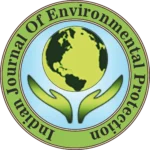IJEP 41(1): 58-65 : Vol. 41 Issue. 1 (January 2021)
Shubhangi S. Malkhede1* and Y. R. M. Rao2
1. MIT, Department of Civil Engineering, Kothrud, Pune – 411 038, Maharashtra, India
2. Dr. Pauls Engineering College, Pulichapallam, Villupuram – 605 109, Tamil Nadu, India
Abstract
An adsorption process is the most effective technique and used for the elimination or reduction of metal ions from wastewater. However, the process is not economical since the activated carbon used as a sorbent is costlier. Hence investigators are inspecting to identify cost-effective, efficient, locally available adsorbent materials. In this research work, attempts have been made to check the efficiency of powdered orange peel (POP) with powdered activated carbon (PAC) in removing Cu2+ ions from the aqueous solution. Experiments have been carried out using the batch mode method. In this removal process, the influence of various physico-chemical parameters, like pH, contact time, adsorbent dose, Cu2+ ions awareness and adsorbent particle size at the adsorption of Cu2+ ions through each POP and PAC were investigated. Results found out that the 69.75% elimination of Cu2+ ions was determined with powdered orange peel at pH 5, contact time 60 min, adsorbent dose 3.5 g/L and Cu2+ ions concentration of 200 ppm. Whereas, the powdered activated carbon has shown elimination of 77.4% at pH 5, contact time of 45 min, adsorbent dose 2.0 g/L and Cu2+ ions concentration of 500 ppm. Equilibrium records had been analyzed using the Langmuir, Freundlich model.
Keywords
Activated carbon, Adsorbent, Adsorption, Batch mode technique, Contact time, Heavy metals, Isotherm, Powdered orange peel
References
- Dundar M., C. Nuhoglu and Y. Nuhoglu. 2008. Biosorption of Cu(II) ions onto the litter of natural trembling poplar forest. J. Hazard. Mater., 151(1): 86-95.
- Verma, R. and P. Dwivedi. 2013. Heavy metal water pollution- A case study. Recent Res. Sci. Tech., 5(5): 98-99.
- Krishna, R.H. and A.V.V.S. Swamy. 2012. Physico-chemical key parameters, Langmuir and Freundlich isotherm and Lagergren rate constant studies on the removal of divalent nickel from the aqueous solutions onto powder of calcined brick. Int. J. Eng. Res. Develop., 4(1): 29-38.
- Ghasemi, M., et al. 2014. Kinetic and equilibrium study of Ni(II) sorption from aqueous solutions onto Peganum harmala L. Int. J. Env. Sci. Tech., 11: 1835-1844.
- Bhargava, A. and A.K. Minocha. 2006. Conventional and non-conventional adsorbents for removal of pollutants from water – A review. Indian J. Chem. Tech., 13: 203-217.
- Okoli, J. and I. Ezuma. 2014. Studies of heavy metals by low-cost adsorbents. J. Appl. Sci. Env. Manage., 18(3): 443-448.
- Boumchita, S., et al. 2017. Application of peanut shell as a low-cost adsorbent for the removal of anionic dye from aqueous solutions. J. Mater. Env. Sci., 8(7): 2353-2364.
- Paramasivam, M. and C. Namasivayam. 1995. Removal of Ni(II) from aqueous solution and nickel plating industry wastewater using agricultural waste: Peanut hull. Waste Manage., 15(1): 63-68.
- Geetha, K.S. and S.L. Belagali. 2013. Removal of heavy metals and dyes using low-cost adsorbents from aqueous medium- A review. IOSR J. Env. Sci. Toxicol. Food Tech., 4(3):56-68.
- Altundogan, H.S., N.E. Arslan and F. Tumen. 2007. Copper removal from aqueous solutions by sugar beet pulp treated by NaOH and citric acid. J. Hazard. Mater., 149(2): 432-439.
- Benaissa, H. and M.A. Elouchdi. 2007. Removal of copper ions from aqueous solutions by dried sunflower leaves. Chem. Eng. Processing. 46(7): 614-622.
- Khormaei, M., et al. 2007. Copper biosorption from aqueous solutions by sour orange residue. J. Hazard. Mater., 149(2): 269-274.
- Saeed, A., M.W. Akhter and M. Iqbal. 2005. Removal and recovery of heavy metals from aqueous solution using papaya wood as a new biosorbent. Separation Purification Tech., 45(1): 25-31.
- Rahman, F.B.A., M. Akter and M. Z. Abedin. 2013. Dyes removal from textile wastewater using orange peels. Int. J. Sci. Tech. Res., 2(9):47-50.
- Sha, L. 2009. Adsorption of Cu2+and Cd2+from aqueous solution by mercapto-acetic acid modified oange peel. Collides Surfaces B Biointerfaces. 73:1-4.
- Rao, V.V.B., C. Sailu and D.K. Sandilya. 2007. An experimental study of liquid-particle flow in circulating fluidized bed. Chem. Eng. Comm., 194:353-357.
- Ugwekar, R.P. and G.P. Lakhawat. 2012. Recovery of heavy metal by adsorption using peanut hull. Int. J. Adv. Eng. Tech., 3(3):39-43.
- Torrado, A. M., et al. 2011. Citric acid production from orange peel wastes by solid-state fermentation. Brazilian J. Microbiol., 42(1): 394-409.
- Rao, M., A.V. Parwate and A.G. Bhole. 2002. Removal of Cr6+and Ni2+from aqueous solution using bagasse and fly ash. Waste Manage., 22(7): +821-830.
- APHA. 2005. Standard methods for the examination of water and wastewater (21st edn). American Public Health Association, Washington DC.
- Kowanga, K. D., et al. 2016. Kinetic, sorption isotherms, pseudo-first-order model and pseudo-second-order model studies of Cu(II) and Pb(II) using defatted Moringa oleifera seed powder. J. Phytopharmacol., 5(2): 71-78.
- Habib, A., et al. 2007. Removal of copper from aqueous solution using orange peel, sawdust and bagasse. Pakistan J. Anal. Env. Chem., 8(1):21-25.
- Rao, M., A.V. Parwate and P. A. Kadu. 2003. Performance of low-cost adsorbents for the removal of copper and lead using low-cost adsorbent materials. J. Water Supply: Res. Tech. – AQUA. 52(1): 49-58.
- Kumar, P.S., et al. 2010. Kinetics and equilibrium studies of Pb2+in removal from aqueous solutions by use of nano-silversol-coated activated carbon. Brazilian J. Chem. Eng., 27(2):339-346.
